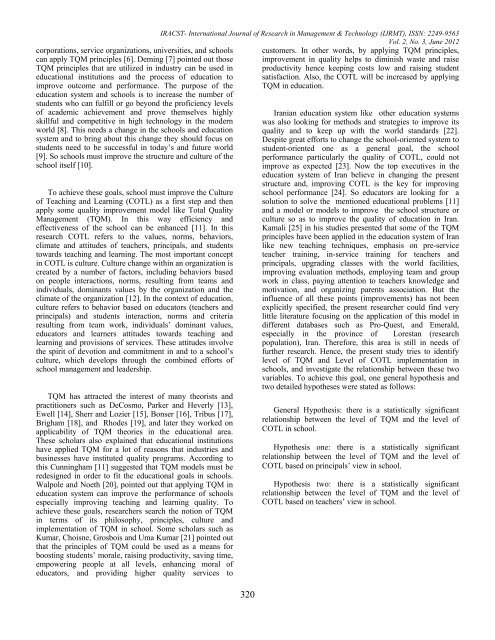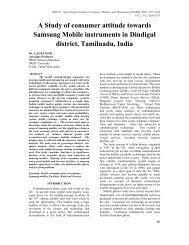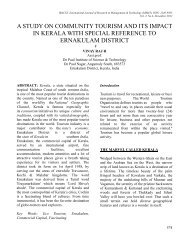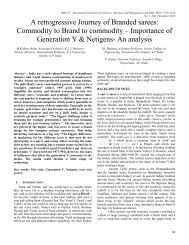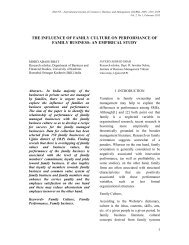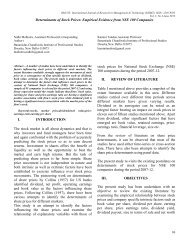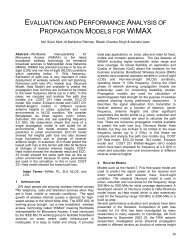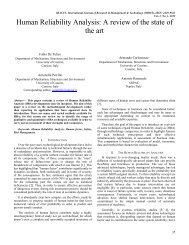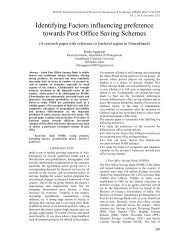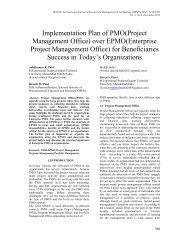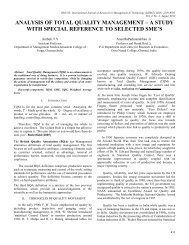The Relationship between Level of Total Quality Management (TQM ...
The Relationship between Level of Total Quality Management (TQM ...
The Relationship between Level of Total Quality Management (TQM ...
- No tags were found...
Create successful ePaper yourself
Turn your PDF publications into a flip-book with our unique Google optimized e-Paper software.
corporations, service organizations, universities, and schoolscan apply <strong>TQM</strong> principles [6]. Deming [7] pointed out those<strong>TQM</strong> principles that are utilized in industry can be used ineducational institutions and the process <strong>of</strong> education toimprove outcome and performance. <strong>The</strong> purpose <strong>of</strong> theeducation system and schools is to increase the number <strong>of</strong>students who can fulfill or go beyond the pr<strong>of</strong>iciency levels<strong>of</strong> academic achievement and prove themselves highlyskillful and competitive in high technology in the modernworld [8]. This needs a change in the schools and educationsystem and to bring about this change they should focus onstudents need to be successful in today’s and future world[9]. So schools must improve the structure and culture <strong>of</strong> theschool itself [10].To achieve these goals, school must improve the Culture<strong>of</strong> Teaching and Learning (COTL) as a first step and thenapply some quality improvement model like <strong>Total</strong> <strong>Quality</strong><strong>Management</strong> (<strong>TQM</strong>). In this way efficiency andeffectiveness <strong>of</strong> the school can be enhanced [11]. In thisresearch COTL refers to the values, norms, behaviors,climate and attitudes <strong>of</strong> teachers, principals, and studentstowards teaching and learning. <strong>The</strong> most important conceptin COTL is culture. Culture change within an organization iscreated by a number <strong>of</strong> factors, including behaviors basedon people interactions, norms, resulting from teams andindividuals, dominants values by the organization and theclimate <strong>of</strong> the organization [12]. In the context <strong>of</strong> education,culture refers to behavior based on educators (teachers andprincipals) and students interaction, norms and criteriaresulting from team work, individuals’ dominant values,educators and learners attitudes towards teaching andlearning and provisions <strong>of</strong> services. <strong>The</strong>se attitudes involvethe spirit <strong>of</strong> devotion and commitment in and to a school’sculture, which develops through the combined efforts <strong>of</strong>school management and leadership.<strong>TQM</strong> has attracted the interest <strong>of</strong> many theorists andpractitioners such as DeCosmo, Parker and Heverly [13],Ewell [14], Sherr and Lozier [15], Bonser [16], Tribus [17],Brigham [18], and Rhodes [19], and later they worked onapplicability <strong>of</strong> <strong>TQM</strong> theories in the educational area.<strong>The</strong>se scholars also explained that educational institutionshave applied <strong>TQM</strong> for a lot <strong>of</strong> reasons that industries andbusinesses have instituted quality programs. According tothis Cunningham [11] suggested that <strong>TQM</strong> models must beredesigned in order to fit the educational goals in schools.Walpole and Noeth [20], pointed out that applying <strong>TQM</strong> ineducation system can improve the performance <strong>of</strong> schoolsespecially improving teaching and learning quality. Toachieve these goals, researchers search the notion <strong>of</strong> <strong>TQM</strong>in terms <strong>of</strong> its philosophy, principles, culture andimplementation <strong>of</strong> <strong>TQM</strong> in school. Some scholars such asKumar, Choisne, Grosbois and Uma Kumar [21] pointed outthat the principles <strong>of</strong> <strong>TQM</strong> could be used as a means forboosting students’ morale, raising productivity, saving time,empowering people at all levels, enhancing moral <strong>of</strong>educators, and providing higher quality services toIRACST- International Journal <strong>of</strong> Research in <strong>Management</strong> & Technology (IJRMT), ISSN: 2249-9563Vol. 2, No. 3, June 2012customers. In other words, by applying <strong>TQM</strong> principles,improvement in quality helps to diminish waste and raiseproductivity hence keeping costs low and raising studentsatisfaction. Also, the COTL will be increased by applying<strong>TQM</strong> in education.320Iranian education system like other education systemswas also looking for methods and strategies to improve itsquality and to keep up with the world standards [22].Despite great efforts to change the school-oriented system tostudent-oriented one as a general goal, the schoolperformance particularly the quality <strong>of</strong> COTL, could notimprove as expected [23]. Now the top executives in theeducation system <strong>of</strong> Iran believe in changing the presentstructure and, improving COTL is the key for improvingschool performance [24]. So educators are looking for asolution to solve the mentioned educational problems [11]and a model or models to improve the school structure orculture so as to improve the quality <strong>of</strong> education in Iran.Kamali [25] in his studies presented that some <strong>of</strong> the <strong>TQM</strong>principles have been applied in the education system <strong>of</strong> Iranlike new teaching techniques, emphasis on pre-serviceteacher training, in-service training for teachers andprincipals, upgrading classes with the world facilities,improving evaluation methods, employing team and groupwork in class, paying attention to teachers knowledge andmotivation, and organizing parents association. But theinfluence <strong>of</strong> all these points (improvements) has not beenexplicitly specified, the present researcher could find verylittle literature focusing on the application <strong>of</strong> this model indifferent databases such as Pro-Quest, and Emerald,especially in the province <strong>of</strong> Lorestan (researchpopulation), Iran. <strong>The</strong>refore, this area is still in needs <strong>of</strong>further research. Hence, the present study tries to identifylevel <strong>of</strong> <strong>TQM</strong> and <strong>Level</strong> <strong>of</strong> COTL implementation inschools, and investigate the relationship <strong>between</strong> these twovariables. To achieve this goal, one general hypothesis andtwo detailed hypotheses were stated as follows:General Hypothesis: there is a statistically significantrelationship <strong>between</strong> the level <strong>of</strong> <strong>TQM</strong> and the level <strong>of</strong>COTL in school.Hypothesis one: there is a statistically significantrelationship <strong>between</strong> the level <strong>of</strong> <strong>TQM</strong> and the level <strong>of</strong>COTL based on principals’ view in school.Hypothesis two: there is a statistically significantrelationship <strong>between</strong> the level <strong>of</strong> <strong>TQM</strong> and the level <strong>of</strong>COTL based on teachers’ view in school.


